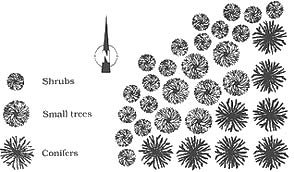Planting for wildlife habitat
Landowners can attract a variety of wildlife to their property by planting a mixture of conifers, hardwoods and shrubs. The Woody Cover for Wildlife [PDF] publication is available for landowners to determine how to best provide for wildlife.
Suitable location
The first step in the establishment of good wildlife habitat is proper site location. There are several factors to consider when planning for wildlife habitat.
Relationship to other habitat components
Cover plantings placed in any odd corner of a farm or property will attract some wildlife, but placing these plantings in relation to existing travel lanes, good undisturbed nesting cover, wetlands or food and watering areas can greatly increase their use by diverse and abundant wildlife. Ideally, winter food such as corn stubble or a planted corn food plot should be located within 100 yards of the cover planting and preferably downwind. This provides easy access to food with a minimum of exposure to predators and winter weather. Adjacent, undisturbed grassy or herbaceous cover will provide insect food and secure nesting.
Exposure
One of the primary benefits of a well-located cover planting is relief from periods of stress such as mid-winter winds. In Wisconsin, severe north and west facing slopes should be avoided. East, south and moderately sloping west facing sites are preferred. The better the sunlight on these sites, the better the flowering and fruit development.
Soils
Most of the shrub species available today require well-drained, loamy soils for best development and growth. Avoid very shallow soils (6 inches or less to bedrock), droughty or sandy soils with very low fertility and excessively wet or poorly drained soils.
Existing permanent cover
There may be opportunities to use your wildlife packet to enhance existing cover such as old farm groves, fence lines, shrub wetlands or other woody cover areas. However, some open grassland areas are better left unplanted. Consult with your local wildlife manager for recommendations.
When enhancing woody cover, some existing trees and shrubs may, if left unchecked, limit the development of the planting. Small trees such as elm and box elder will grow faster than the planting and eventually become "wolf" trees, whose shade and competition will greatly lower the growth and vigor of your planting. Unwanted trees and shrubs should be removed prior to planting. Most Wisconsin deciduous trees and shrubs are prolific sprouters and in one year can grow 3-5 feet from cut stumps. To prevent sprouting, it's best to treat the stump with a recommended herbicide.
A planting plan
The arrangement of shrubs and trees in a planting can greatly affect its attractiveness to wildlife. For example, depending on exposure, it's advisable to plant one or two rows of shrubs on the windward side of the planting to trap snow. Conversely, it is advantageous to have at least two rows on the downwind or protected side to provide resting or sunning areas.
Square planting designs are preferable to a long, thin planting. The blocky shape should provide an area to catch the snow on the north and west sides of the planting with inner rows of conifers to provide shelter from weather and predators. Plant species in groups with adequate spacing so that no single species will predominate and out-compete the others.
The following are recommended species and spacing for woody cover wildlife plantings. Woody Cover for Wildlife [PDF] contains detailed information on individual tree species’ characteristics.
Shrubs
Space plants 4 feet apart in rows and 6 feet apart between rows.
- Prairie crabapple
- American highbush cranberry
- Red-osier dogwood
- Silky dogwood
- American hazelnut
- Juneberry
- Ninebark
- Common winterberry
Small trees
Space plants 8 feet apart in rows and 10 feet apart between rows.
- Hawthorn
- American plum
Conifers
Space 12 feet apart in rows and 15 feet apart between rows.
- White cedar
- White spruce
The ideal planting design for your wildlife packet is illustrated in Figure 1. It consists of a 12-row planting 200 feet long and 165 feet wide (about 3/4 of an acre). This design has two rows of dense shrubs on the windward side to catch snow. The 35-foot gap between the first two rows of shrubs and row 3 serves as an area for snow to be deposited without burying the inner rows of trees. Additional shrubs and conifers are planted downwind to provide food, cover, sunning and loafing areas. Alternatively, you can plant your packet in clumps scattered around the farm as illustrated in Figure 2.


